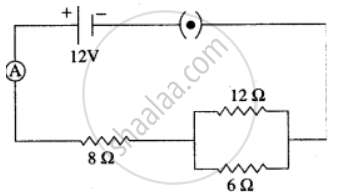Advertisements
Advertisements
प्रश्न
Three resistors are connected to a 12 V battery as shown in the figure given below:

(i) What is the current through the 8 ohm resistor?
(ii) What is the potential difference across the parallel combination of 6 ohm and 12 ohm resistor?
(iii) What is the current through the 6 ohm resistor?
उत्तर
(i) 6 ohm and 12 ohm are connected in parallel, So
⇒ `1/"R"_1 = 1/6 + 1/12 = (2 + 1)/12 = 3/12`
⇒ `1/"R"_1 = 1/4`
R1 = 4 ohm.
∴ Total Resistance R = 8 + 4 = 12 ohm.
Now ∵ V = IR
⇒ 12 = I × 12
∴ I = 1 Amp.
(ii) V = IR = 1 ×4 = 4 Volt
(iii) ∵ V = I1R
⇒ 4 = I1 × 6
∴ I1 = `4/6`
= 0.66 Amp.
APPEARS IN
संबंधित प्रश्न
How much energy is given to each coulomb of charge passing through a 6 V battery?
What is meant by saying that the electric potential at a point is 1 volt?
How much work is done in moving a charge of 2 C across two points having a potential difference of 12 V?
The V-I graph for a series combination and for a parallel combination of two resistors is shown in Fig – 8.38. Which of the two, A or B, represents the parallel combination? Give a reason for your answer.
A boy records that 4000 joules of work are required to transfer 10 coulombs of charge between two points of a resistor of 50 Ω. The current passing through it is:
Electric potential is a ____________.
A cylindrical conductor of length l and uniform area of cross section A has resistance R. Another conductor of length 2l and resistance R of the same material has area of cross section
Inside a hollow charged spherical conductor, the potential ______
Twenty-seven drops of the same size are charged at 220 V each. They combine to form a bigger drop. Calculate the potential of the bigger drop.
